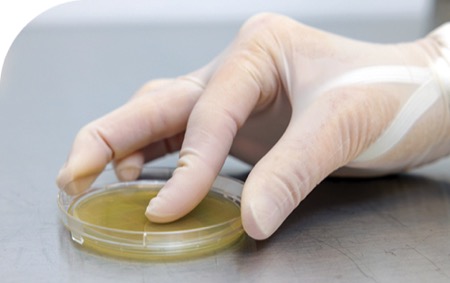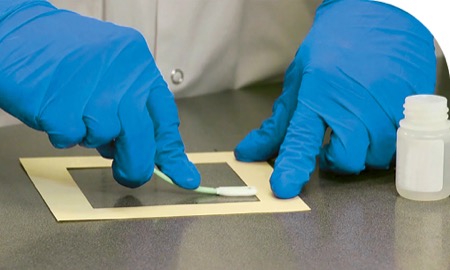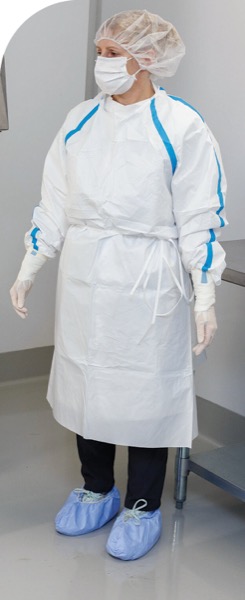Originally published by our sister publication Pharmacy Practice News
It’s a new era for sterile compounding, with USP’s revised General Chapter <797> finally official, and The Joint Commission, other accreditors, and state and federal agencies conducting inspections based on the new chapter’s requirements. Experts who have visited hospital pharmacies that perform sterile compounding say they already have seen a few common compliance gaps emerge.
Environmental Monitoring and Cleaning
Surface sampling has changed significantly in the new Chapter <797>, and institutions that previously relied on their outside certifiers to conduct their surface sampling every six months are now faced with the prospect of doing monthly sampling themselves.
“It generally doesn’t make sense to have a certifier coming in every month,” said Patricia Kienle, RPh, MPA, BCSCP, FASHP, the director of accreditation and medication safety at Cardinal Health. “But now in-house personnel need to develop skills in doing the sampling themselves. Some places are taking only a couple of samples, which is not adequate based on current guidelines, and at others, it’s overkill with sampling almost the entire room.”
Samples must be taken in each classified area, including each room, and the interior of each ISO Class 5 primary engineering control and any pass-through chamber opening into an ISO-classified area, as outlined in Section 6.3.1 of the chapter. “Any equipment that is in your hoods, including repeater pumps, compounders and cameras, should be included in surface sampling,” Ms. Kienle said. “Frequently touched surfaces should also be sampled, including work surfaces near the hood such as countertops, as well as door handles of refrigerators or handles on manual doors.”
Many institutions misunderstand how to perform viable surface sampling, added Abby Roth, BS, CMQ/OE, the founder of Pure Microbiology. “People think this is easier than it actually is. There is a lot of technique involved, and that’s not specifically explained in the chapter.”
To further illustrate the point, Ms. Roth cited a recent training experience at one health system. “I explained that you need to first collect the sample, then wipe the surface with a cleaning and disinfecting agent. One staff member’s face dropped because she had been told to clean the surface first and then take the sample. I’ve conducted so many classes like that, where people say, ‘We’ve been doing this all wrong.’ Maybe someone watched a YouTube video that might not have even been specific to the environmental monitoring we do in pharmacy, and was trying to wing it. Training needs to come from a subject matter expert.”
Ms. Kienle cited another new element of environmental monitoring and cleaning that is often still falling through the cracks: Any cleaning solution used inside the hood must be sterile. “There are still people who are using alcohol, thinking it is a cleaner. Alcohol is a sanitizing agent,” she said, while acknowledging that some agents used in the cleaning process have accompanying odors. “These agents are oxidizers, so they all smell, particularly if you are pouring large quantities in open areas. But there are ways of controlling the smell if you follow the manufacturer’s instructions.”
Understanding Required Competencies
Compounders and those who have direct oversight of compounders must now undergo garbing competency evaluations, including visual observation as well as gloved fingertip and thumb sampling of both hands, at least every six months. (Previous evaluations were done annually for most situations.) The garbing process must be completed successfully three times in a row.
Some aspects of garbing are flexible and up to the facility, Ms. Roth said. “For example, a common garbing question is where to don gloves. Do you do it in the anteroom? In the buffer room? That’s not dictated by the chapter, so it’s up to you to decide, based on considerations like how much room you have in the anteroom, whether or not you have hands-free doors, and whether you are doing hazardous versus nonhazardous compounding.”
USP guidelines also require facilities to document aseptic manipulation competency at least every six months (every three months for those involved in Category 3 compounding). “This process involved three steps, where there used to be only two,” Ms. Kienle said. “First, they perform the media fill, followed by a gloved fingertip test, followed by surface sampling. The surface sample is the new element. The goal is to demonstrate that you can aseptically make an IV, that you can do that without contaminating yourself, and that you can keep the area around you pristine and aseptic while doing so. I have seen questions around the right order to do this, which makes me think people don’t understand the process yet.”
Cut-and-Paste Doesn’t Cut It
Ms. Roth has observed that some institutions have created their standard operating procedures (SOPs) for requirements such as environmental monitoring, garbing and media fill testing by cutting and pasting language either directly from the chapter or a borrowed template.
“They’re not changing the template language to match what they are actually doing,” she said. “Your institution’s SOPs need detail, [and] should be specific and clear. I worked in a contract lab for years, and we had SOPs that were concise and specific: If you were using this piece of equipment, there was an SOP for how to do it. I’m seeing SOPs that are all lumped together in one 30-page document. No one is going to read that! But they might read 15 two-page SOPs that are focused on specific elements.”
Some aspects of SOPs can be broader, she acknowledged. “If you have an excursion, for example, your SOPs can define the process without going into every detail: Report it to management, begin the investigation, undertake corrective action, verify that the corrective action was successful and close out the investigation,” she said. “That [approach] is sufficient to ensure that you will not miss steps.”
Ms. Roth recommended establishing a team dedicated to creating your facility-related SOPs. “They are the last thing that get any love, but The Joint Commission and others will be focusing on documentation.”
The Joint Commission has clearly stated that it will be focusing significant attention on viable sampling in future inspections, Ms. Roth said. “Operational aspects will be brought to the forefront. Anything you haven’t done yourself previously, or where there has been a significant change, they will be looking at closely.”
A Joint Commission spokesperson confirmed the accuracy of these statements.
Ms. Roth urged hospital pharmacies to take ownership of their process. “Establish what you are going to do in your SOPs and then train everyone in those processes. You understand what’s required and you understand the risks. Stand up and be bold in the decisions that you are making, and be willing to defend them.”
The sources reported no relevant financial disclosures.




